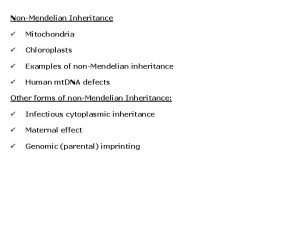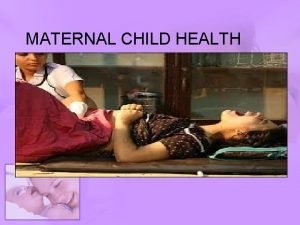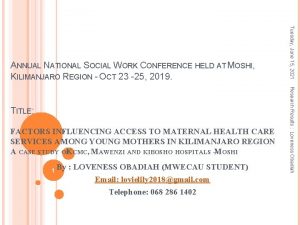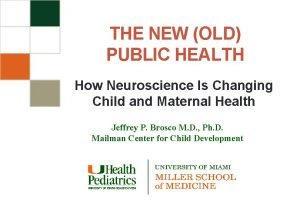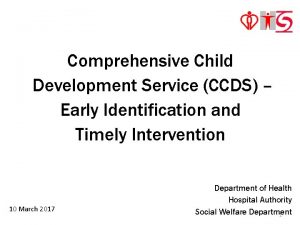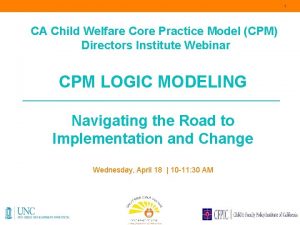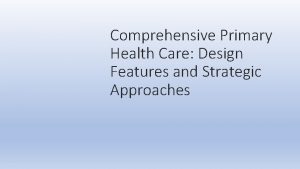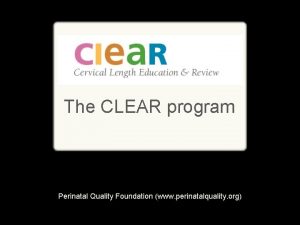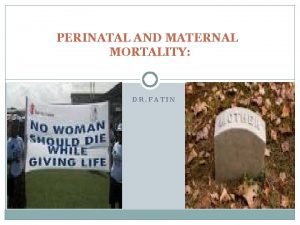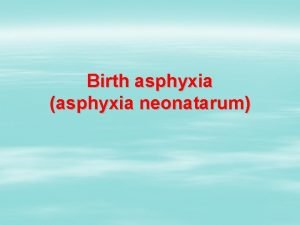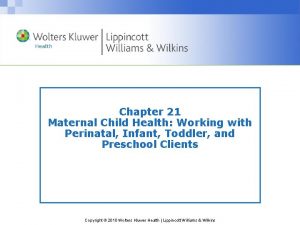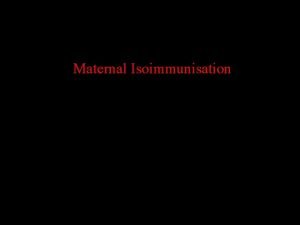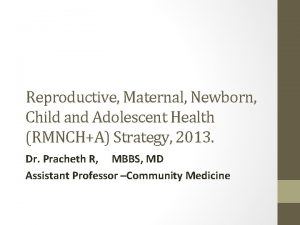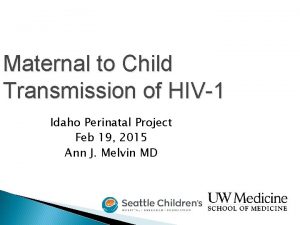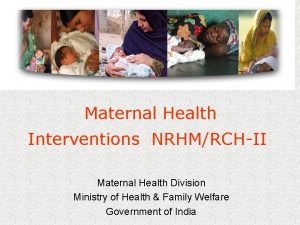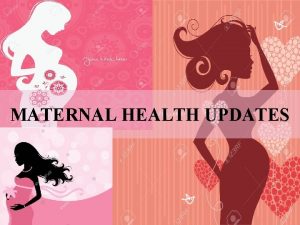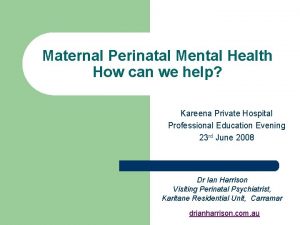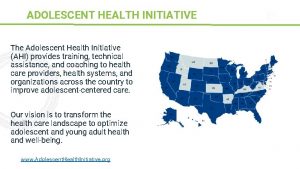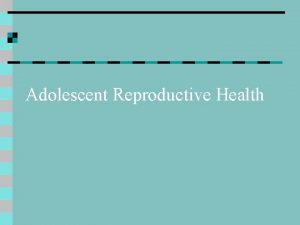California Maternal Child Adolescent Health ProgramMCAH Comprehensive Perinatal



















- Slides: 19

California Maternal, Child & Adolescent Health Program(MCAH) Comprehensive Perinatal Services Program (CPSP) Insert name of PSC Insert Date __________________________________ Insert County Logo 1

What is CPSP? • CPSP provides enhanced perinatal services (nutrition, psychosocial and health education), for Medi-Cal eligible women, from pregnancy through the end of the second month after delivery. • CPSP has been shown to improve birth outcomes, including reducing the incidence of low birth weight in infants and lowering short-term NICU costs. 2

Goals of CPSP • To decrease the incidence of low birthweight in infants • To improve the outcome of every pregnancy • To give every baby a healthy start in life • To lower health care costs by preventing catastrophic and chronic illness in infants and children 3

Why be a CPSP Provider? • Better patient outcomes • Reimbursement for enhanced services in addition to basic obstetrical care • Clinical and administrative consultation for staff through your county Perinatal Service Coordinator 4

CPSP in Managed Care • Medi-Cal managed care plans (Plans) must inform members of childbearing age about the availability of comprehensive perinatal services. • Plans are required to implement a comprehensive risk assessment tool for all pregnant members, comparable to the American College of Obstetricians and Gynecologists (ACOG) and CPSP standards. 5

CPSP Reimbursement for Enhanced Services In addition to basic OB services and the early entry into prenatal care visit occurring within 16 weeks of the patient’s last menstrual period, the following CPSP services may be performed and reimbursed: CPSP Support Services Rendered Maximum Allowable Reimbursement Individual support services: $33. 64/hour (up to 23 hours) $ Group classes $11. 24/patient/hour (up to 27 hours) 773. 72 303. 48 Coordination fee** 85. 34 Prenatal vitamins $3. 00/30 day supply (up to 300 day supply) Allowable Reimbursement 30. 00 ______ $ 1, 192. 54*** ** The coordination fee is only reimbursed if all three support service assessments and the initial pregnancy-related exam are provided within four weeks of entry into care *** The above based on maximum allowable reimbursement without authorization if all support services are provided and billed. In high-risk circumstances, additional support services may be requested through the TAR process 6

CPSP Components • Orientation • Case Coordination • OB • Psychosocial Reassessments • Health Education Assessments • Nutrition • Vitamin/mineral supplementation • Perinatal Education Initial Assessments • Individual • Groups Trimester Postpartum Intervention/follow-up 7

CPSP Model of Care • Client Centered • Strength-based • Multi-disciplinary • Site specific protocols • Culturally sensitive • Community referrals • Voluntary participation 8

Who can Become a CPSP Provider? Any of the following can become a CPSP provider, if they have an active National Provider Identifier (NPI) number and are an active Medi-Cal provider in good standing with Medi-Cal and their licensing board: • Physician (general practitioner, family practitioner, obstetrician/gynecologist or pediatrician) • Group medical practice (at least one member of which is one of the physician types above • Preferred Provider Organization (PPO) • Clinic (hospital, community, or county) • Certified Nurse Midwife (CNM) • Alternative Birth Center 9

Who can be a CPSP practitioner? A practitioner is someone employed or contracted with the provider, who works hands-on with the clients. They provide direct obstetric and CPSP services, appropriate to their skill level. • • Physicians (general practice, family practice, obstetrician/gynecologist, pediatrician) Certified Nurse Midwives Nurse Practitioners Physician Assistants Registered Nurses Licensed Vocational Nurses Social Workers Psychologists 10

Who Can Be a CPSP Practitioner (continued) • Marriage and Family Therapists • Registered Dietitians/Registered Dietitian Nutritionists (RDNs) • Health Educators • Certified Childbirth Educators (Lamaze, Bradley, ICEA) • Licensed Midwives • Comprehensive Perinatal Health Workers (CPHW): • at least 18 years old • High School Diploma or GED • minimum of one year full-time paid perinatal experience 11

Models of CPSP Service Delivery Approved CPSP providers can be found in solo practice, group practice, health departments, hospitals, community clinics, managed care plans, Federally Qualified Health Centers (FQHCs), Indian Health Services (IHS), and Rural Health Clinics (RHCs). • In most cases, the entire CPSP program is offered in a single location. In others, obstetrical services are provided in the provider’s office with support services provided elsewhere, under subcontract, or by a second CPSP provider • Flexibility of program design and implementation allows for the use of a wide range of professional and paraprofessional personnel. • 12

How does the CPSP work in FQHCs and RHCs? • CPSP visits in FQHC/RHC settings are paid at a flat fee per visit as defined in their prospective payment system. • Treatment Authorization Requests (TARs) are not used in FQHCs or RHCs; however, chart documentation for additional CPSP services must include the same justification necessary to obtain a TAR. • For managed care clients, FQHCs and RHCs should bill the Plan first; then Medi-Cal is billed for the remainder of the PPS rate. 13

CPSP Protocols A CPSP Provider must develop written protocols for each enhanced service within six months of being approved as a CPSP provider. Protocols: • Describe site-specific client care from entry through postpartum • Reflect the provider’s current CPSP practices, policies and procedures • Are used by CPSP staff to provide CPSP services 14

Personal Supervision • CPSP services must be provided by or under the personal supervision of a physician. • Personal supervision is defined as evaluation, in accordance with protocols, by a licensed physician, of services performed by others through direct communication, either in person or through electronic means. • CPHWs must work under the direct supervision of a physician. Ø Protocols define how direct supervision occurs and is documented 15

The CPSP Application Process • Your CPSP Perinatal Services Coordinator (PSC) can assist you with your application. • The PSC will review the completed application and submit it to the California Department of Public Health (CDPH) Maternal, Child and Adolescent Health (MCAH) Division for final approval. • The application approval process may take up to 60 days from the date that CDPH/MCAH receives a completed application. 16

Electronic Health Record (EHR) • EHRs should facilitate the CPSP work flow in each provider office. • The provider is responsible for evaluating the content and functionality of the EHR system. • The PSC will review the EHR content using CDPH/MCAH CPSP forms or CPSP Title 22 § 51348 as a guide to assure that the required elements of prenatal and postpartum assessment, reassessment, individualized care plan, and interventions are included. 17

Resources • CPSP Website - https: //www. cdph. ca. gov/Programs/CFH/DMCAH/CPSP/Pages/default. aspx • CPSP Provider Handbook and Steps to Take Manual -http: //www. cvent. com/events/cpsporientation-training-2017 -2018/custom-18 -33484 c 8 f 25 e 74 ce 2 a 1 b 5 a 7482 b 171 e 8 e. aspx • Medi-Cal Website - https: //www. medi-cal. ca. gov/ • CPSP Perinatal Services Coordinators https: //www. cdph. ca. gov/Programs/CFH/DMCAH/CPSP/Pages/Local-Directory. aspx 18

Questions? ? Insert name of person to contact for questions Insert contact email Insert contact phone number Thank You! 19
 Non nuclear inheritance
Non nuclear inheritance Extranuclear inheritance
Extranuclear inheritance History of maternal and child health
History of maternal and child health Maternal and child health services
Maternal and child health services National program for child health
National program for child health Z score for malnutrition
Z score for malnutrition Scaffold and fade-away technique
Scaffold and fade-away technique Infant child and adolescent berk 8th edition chapter 1
Infant child and adolescent berk 8th edition chapter 1 Factors influencing maternal health
Factors influencing maternal health What is maternal health
What is maternal health Jama 2017
Jama 2017 Ashwg
Ashwg Manual of parenting capacity assessment framework swd
Manual of parenting capacity assessment framework swd Cpm implementation
Cpm implementation Comprehensive primary health care approach
Comprehensive primary health care approach Clear perinatal quality
Clear perinatal quality Perinatal matrices
Perinatal matrices Fatin organ
Fatin organ Perinatal asphyxia
Perinatal asphyxia Perinatal asphyxia
Perinatal asphyxia
